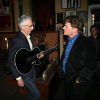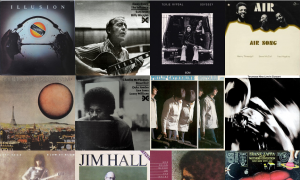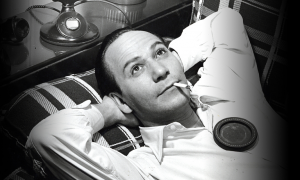Home » Jazz Articles » Top Ten List » Top Jazz-Rock Fusion Recordings
Top Jazz-Rock Fusion Recordings
While organ and electric guitar had been a staple of jazz for a long time, in the late 1960s, Miles Davis included electric bass and piano in some recordings and the music began to stomp more than swing. Later, Miles would play an electric trumpet and even use a waw-waw pedal to great effect. This amplified music was played loudly. Many hailed Miles Davis's 1970 double album, Bitches Brew as the real birth of jazz-rock fusion, given its electric textures and rock rhythms. Certainly, there had been nothing like it and it opened a door that would never be shut. Miles would return to his pre-electric music only when playing Gil Evans material with Quincy Jones at Monterey shortly before Miles's death in 1991.
So much for history, except to note that many of those who explored jazz-rock fusion with Miles—such as Chick Corea, John McLaughlin, and Billy Cobham—went on to start their own fusion bands and to brave new and exciting territory. My list of top ten fusion recordings makes no attempt to be fair or comprehensive. Significant fusion pioneers, such as Larry Coryell are omitted simply because of my taste. Some might consider Herbie Hancock's Headhunters group as jazz-rock fusion, but funk-jazz fusion seems to be a better description.
Those interested in jazz-rock fusion may enjoy listening the following eleven recordings, which will include only officially released material.

Miles Davis: Bitches Brew (1970). This is perhaps the one that started it all. Leave it to Miles, who also contributed to the origin of bebop and free-bop.

Mahavishnu Orchestra: The Inner Mounting Flame (1971)

Mahavishnu Orchestra: Birds of Fire (1973)

Mahavishnu Orchestra: Between Nothingness and Eternity (1973)
These were the only three official recordings of the original (and best) Mahavishnu Orchestra during their brief tenure (1971-73). (There are some fantastic bootlegs of the band, since they played about 500 live gigs.) The Lost Trident Sessions (the material from which was played on Between Nothingness and Eternity) was released in 1999. Guitarist John McLaughlin, who had played with Miles Davis, led the group as a kind of mystic-prophet-virtuoso and wrote tunes with exotic names such, "Dance of Maya" and "Vital Transformation." John was clean shaven, had short hair, and wore white. He had taken a Hindu name Mahavishnu given to him by his guru, was off drugs, and said that God played through him.
This was heady stuff, and it helped me get interested in spirituality as a teenager; but whether you believed it or not, the music could be mesmerizing whatever the metaphysics behind it. I still marvel at the complexity, speed, and beauty of the music performed by McLaughlin on guitar, Jerry Goodman on violin, Rick Laird on bass, Jan Hammer on keyboards, and the athletic Billy Cobham on drums.
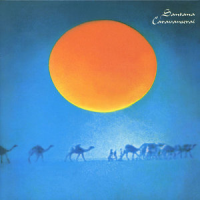
Santana: Caravanserai (Columbia, 1972)
This fourth album by Santana begins with saxophone and acoustic bass. The music is more exploratory and open ended than the first albums. Guitarist Carlos Santana had begun to be influenced by John McLaughlin of the Mahavishnu Orchestra and the two of them would go on to record together on Love, Devotion, and Surrender (Columbia Records, 1973).
Billy Cobham: Spectrum (Atlantic, 1973)
This was the mind-bending drummer's first recording after the breakup of the first Mahavishnu Orchestra in 1973. The tunes were a mixture of hard-driving efforts and more mellow jazzier fare. It featured the fiery guitar playing of Tommy Bolin on several of the heavier cuts.
Return to Forever: Romantic Warrior (Columbia Records, 1976)
In the spring of 1976, the band (Chick Corea on keyboards, Stanley Clarke on bass, Al Di Meola on guitar, and Lenny White on drums) went into the Rockies to record this album. They then played the entire album at a gig in a small Denver club that I attended in amazement. The compositions are beautiful and intricate, and the playing superb.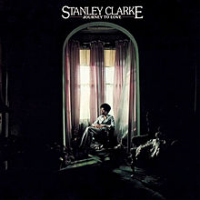
Stanley Clarke, Journey to Love (Nemperor, 1975)
Acoustic and electric bassist Clarke made his name with Return to Forever, but quickly began a solo career. He was, I believe, the first electric bassist to use the "slap bass" technique, which is now a staple of electric bass players in jazz, rock, and funk. He played with both speed and precision, but never at the expense of good taste.
Weather Report: Heavy Weather (Columbia, 1977)
Lead by Joe Zawinul on keyboards and with Wayne Shorter on saxophone, in 1975, the band was transformed by the addition of electric fretless bassist Jaco Pastorius, who played like no one before him. This recording includes their popular song, "Birdland." Unlike much of other jazz-rock fusion, Weather Report's offerings were never cluttered or hurried. Within the spaces came the magic.
Jean-Luc Ponty: Live (Atlantic, 1979)
The French electric violinist had come up playing more traditional jazz, but ventured into fusion in the early 1970s. He is a lyrical virtuoso, and this band of two guitar players, keyboards, bass, and drums is superb.
Allan Holdsworth: Hard Hat Area (Polydor, 1993)
Allan Holdsworth (1946-2017) was a force of nature, but that would too weak a phrase. Holdsworth's box set is called, The Man Who Changed Guitar Forever (Manifesto Records, 2017), but that isn't true. He played like no other, but no one really sounds like him. The same was true for Thelonious Monk on piano. Holdsworth could play at superhuman speed and fluidity and in scales unknown to most. John McLaughlin once said he had no idea how Holdsworth played what he did. Perhaps the only one who did was Mr. Holdsworth.The jazz-rock genre is still with us, although it does not command the attention or bear the originality it once did. Jean-Luc Ponty, John McLaughlin, Billy Cobham, and Stanley Clarke still perform and record in this style. Perhaps the glory days are gone, but the spirit remains
Tags
Top Ten List
The Mahavishnu Orchestra
Douglas Groothuis
Billy Cobham
Stanley Clarke
Return To Forever
Weather Report
Jean-Luc Ponty
Allan Holdsworth
john mclaughlin
Santana
Bitches Brew
Birds Of Fire
Between Nothingness and Eternity
The Inner Mounting Flame
Caravanserai
Romantic Warrior
Journey To Love
Heavy Weather
Jean-Luc Ponty: Live
Hard Hat Area
About Mahavishnu Orchestra
Instrument: Band / ensemble / orchestra
PREVIOUS / NEXT
Support All About Jazz
 All About Jazz has been a pillar of jazz since 1995, championing it as an art form and, more importantly, supporting the musicians who make it. Our enduring commitment has made "AAJ" one of the most culturally important websites of its kind, read by hundreds of thousands of fans, musicians and industry figures every month.
All About Jazz has been a pillar of jazz since 1995, championing it as an art form and, more importantly, supporting the musicians who make it. Our enduring commitment has made "AAJ" one of the most culturally important websites of its kind, read by hundreds of thousands of fans, musicians and industry figures every month.

